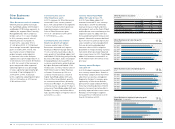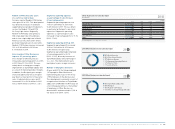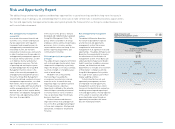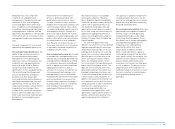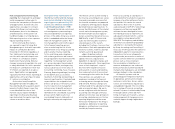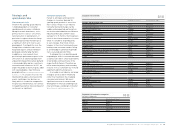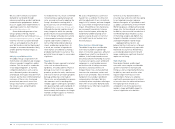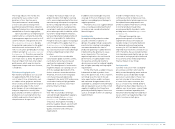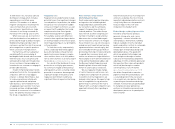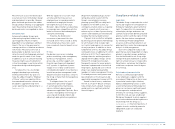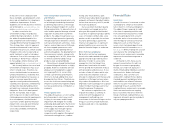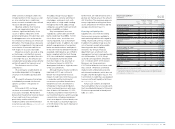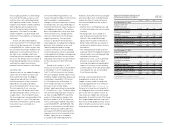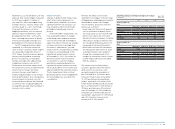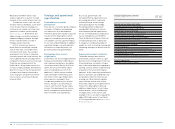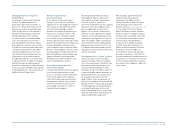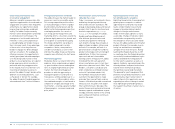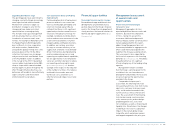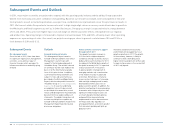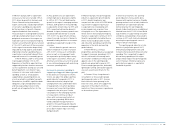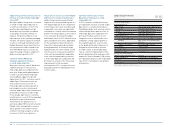Reebok 2010 Annual Report Download - page 170
Download and view the complete annual report
Please find page 170 of the 2010 Reebok annual report below. You can navigate through the pages in the report by either clicking on the pages listed below, or by using the keyword search tool below to find specific information within the annual report.
166 Group Management Report – Financial Review Risk and Opportunity Report
In the event of non-compliance with
these standards, we develop joint action
plans and set deadlines for compliance
and further improvement. If these
deadlines are not met, business relations
are terminated see Sustainability, p. 120,
and www.adidas-Group.com/sustainability.
In order to minimise the
environmental impact of producing
and distributing our products, in 2010
the adidas Group developed its first
fully comprehensive environmental
strategy (Environmental Strategy 2015).
This strategy takes a holistic approach
towards environmental issues such as
sustainable resource use, climate change
mitigation, emissions to water and air,
waste treatment as well as hazardous
substances. Part of this strategy is also
to extend our “Better Place” initiative
to more adidas athletic footwear and
apparel products see Sustainability, p. 120.
We currently believe that social and
environmental malpractice may occur
only in isolated cases. Therefore, we
assess the likelihood of occurrence as
unlikely. Nevertheless, we believe that,
going forward, legislative measures as
well as consumer expectations with
regard to socially and environmentally
sound business practices and behaviour
will become more demanding, which
will add to our corporate responsibility
obligations. Due to this development
we will, for example, have to cope
with rising costs in order to fulfil more
challenging environmental requirements.
As a consequence, the likelihood of
occurrence and the potential financial
impact from social and environmental
risks have increased and are now
assessed as probable and moderate,
respectively.
Risks from product counterfeiting
and imitation
As popular consumer brands which rely
on technological and design innovation
as defining characteristics, the Group’s
brands are frequent targets for counter-
feiting and imitation. To reduce the loss of
sales and the potential damage to brand
reputation resulting from counterfeit
products, the adidas Group makes use
of extensive legal protection (generally
through registration) and works closely
with law enforcement authorities, inves-
tigators and outside counsel. Although
we have stepped up measures such
as product security labelling with our
authorised suppliers, the development of
these measures remains a key priority
on an ongoing basis. In 2010, more than
12 million counterfeit adidas Group
products were seized worldwide.
We continue to regard the likelihood
of counterfeiting and imitation as highly
probable. However, we believe we have
adequate costs budgeted to support
our ongoing efforts to successfully
combat counterfeiting and imitation,
which also include adding more local
brand protection officers. Therefore, we
assess the risk from counterfeiting and
imitation to potentially negatively impact
our forecasted financial contribution as
moderate.
Product quality risks
The adidas Group faces a risk of selling
defective products, which may result
in injury to consumers and/or image
impairment. We mitigate this risk by
employing dedicated teams that monitor
the quality of our products on all levels
of the supply chain through rigorous
testing prior to production, close
cooperation with suppliers throughout
the manufacturing process, random
testing after retail delivery, open
communication about defective products
and quick settlement of product liability
claims when necessary. In 2010, we did
not recall any products.
Our assessment of product quality
risks remains unchanged versus the
prior year. We regard the likelihood of
occurrence of significant product liability
cases or having to conduct wide-scale
product recalls as possible. As we have
insurance protecting us against the
financial consequences of significant
product liability cases, we assess the
potential financial impact as moderate.
Risks from non-compliance
We face the risk that our employees
breach rules and standards that guide
appropriate and responsible business
behaviour. In order to successfully
manage this risk, the Group Policy
Manual was launched at the end of
2006 to provide the framework for basic
work procedures and processes. It also
includes a Code of Conduct which stip-
ulates that every employee shall act
ethically in compliance with the laws and
regulations of the legal systems where
they conduct Group business. All of our
employees have to participate in a special
Code of Conduct training as part of our
Global Compliance Programme.
We continue to regard the risks
of grave misconduct as unlikely. In
connection with the updated risk
management methodology, our
assessment of the financial impact on the
Group, in case they should materialise,
has decreased and is now regarded as
minor.
Financial Risks
Credit risks
A credit risk arises if a customer or other
counterparty to a financial instrument
fails to meet its contractual obligations.
The adidas Group is exposed to credit
risks from its operating activities and
from certain financing activities. Credit
risks arise principally from accounts
receivable and to a lesser extent from
other third-party contractual financial
obligations such as other financial
assets, short-term bank deposits and
derivative financial instruments see
Note 28, p. 208. Without taking into account
any collateral, the carrying amount of
financial assets and accounts receivable
represents the maximum exposure to
credit risk.
At the end of 2010, there was no
relevant concentration of credit risk
by type of customer or geography.
Instead, our credit risk exposure is
mainly influenced by individual customer
characteristics. Under the Group’s
credit policy, new customers are
analysed for creditworthiness before
standard payment and delivery terms
and conditions are offered. Tolerance
limits for accounts receivable are also
established for each customer. Both
creditworthiness and accounts receivable
limits are monitored on an ongoing
basis. Customers that fail to meet the
Group’s minimum creditworthiness are
in general allowed to purchase products
only on a prepayment basis.


